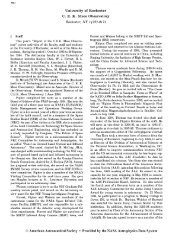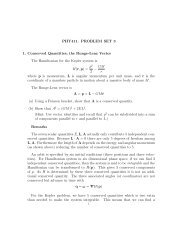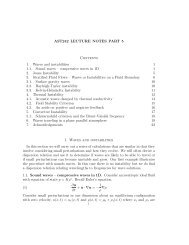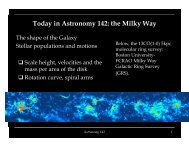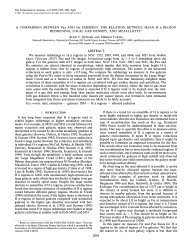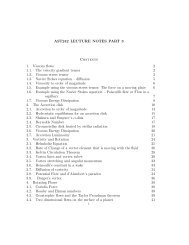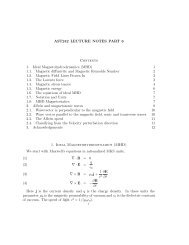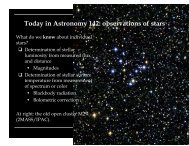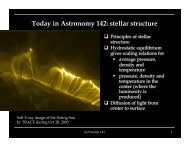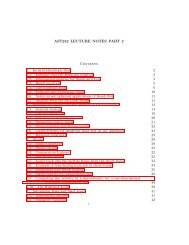Development of infrared focal plane arrays for space - Astro Pas ...
Development of infrared focal plane arrays for space - Astro Pas ...
Development of infrared focal plane arrays for space - Astro Pas ...
You also want an ePaper? Increase the reach of your titles
YUMPU automatically turns print PDFs into web optimized ePapers that Google loves.
FIG. 20. Read noise in a 2525 box at the center 128,128 <strong>of</strong> FPA CRC744-40716 vs temperature. The curves <strong>for</strong> N samp 1,8,32 were obtained in the Dewarwarming up process and the statistical uncertainty in each point is 0.04. The two N samp 64 data points were obtained when the dewar was stabilized at14.6 and 28.5 K and the statistical uncertainty in each point is 0.02.smaller than those displayed in Fig. 20 <strong>for</strong> similar conditions.Two factors may cause this difference:1 The data in Table VIII were acquired when temperaturewas stabilized, whereas the data in Fig. 20 were obtainedas the Dewar warmed up.2 When acquiring the data in Table VIII, after a parameter,e.g., the number <strong>of</strong> samples was changed, the same measurementswere per<strong>for</strong>med four times, and the averagewas obtained. However, when acquiring the data in Fig.20, Fowler mode noise measurements with differentnumbers <strong>of</strong> samples were interspersed with SRP andR-G mode noise measurements, and Fowler mode QEmeasurement. It is a less stabilized situation and couldcontribute to a small increment in read noise.Recently, after fixing a small problem in our pre-ampboard, we achieved 5 e <strong>of</strong> read noise <strong>for</strong> CRC744-40716with 12 s integration time and 7 e <strong>for</strong> CRC744-41626 with200 s integration time at 15 K with 64 sample pairs.The FPA read noise <strong>of</strong> the Fowler sampling mode 3,4should be dominated by the voltage noise <strong>of</strong> V n <strong>of</strong> the sourcefollower metal-oxide-semiconductor field-effect transistorMOSFET in the unit cell. This can be calculated fromnC v0 V n2 f21cos2 f int 1 f / f 0 2sin 2 N f N 2 sin 2 f df,where n is the read noise in electrons, C v is the integratingnode capacitance in e /V, V n 2 /f is the power spectral density<strong>of</strong> the source follower FET, N is the number <strong>of</strong> Fowlersample pairs, f 0 is the 3 dB cut<strong>of</strong>f frequency <strong>of</strong> thebandwidth-limiting RC filter, int is the integration time, and is the time between two successive sample pairs. Frommeasurements on various FETs using the same processingemployed <strong>for</strong> the CRC744, the FET noise power spectraldensity V 2 n / f can be estimated. Scaling to the size <strong>of</strong> theunit cell FETs at a temperature 14.5 K this becomes2V nV 2 /Hz, f 1.510 16 5.11012 f /Hz 0.77 with f 0 1 MHz/2 <strong>of</strong> the RC filter preceding our A/D converters.The second term, the flicker noise, is much moreimportant than the first term, the white, or thermal, noise.This noise prediction at 14.5 K is plotted in Fig. 19 in comparisonto the measured read noise from two CRC744 InSbFPAs.F. Power dissipationThe power dissipation at 400 mV bias and around 14.5K was measured with the FPA running in the following fourdifferent readout modes: flat-out with output amplifiers on,flat-out with output amplifiers <strong>of</strong>f, park-mode with outputamplifiers on, and park-mode with output amplifiers <strong>of</strong>f. Themeasurements are described as follows: fanout temperatureswere measured at ‘‘power <strong>of</strong>f,’’ in which all voltages to allpins were set to zero, and in each <strong>of</strong> the above readout3576 Rev. Sci. Instrum., Vol. 68, No. 9, September 1997 IR <strong>focal</strong> <strong>plane</strong> <strong>arrays</strong>Downloaded 21 Jun 2012 to 128.151.144.191. Redistribution subject to AIP license or copyright; see http://rsi.aip.org/about/rights_and_permissions




